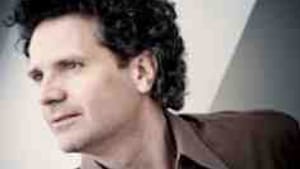Stay in the Loop
BSR publishes on a weekly schedule, with an email newsletter every Wednesday and Thursday morning. There’s no paywall, and subscribing is always free.
A thing for Wagner
Pianist Andreas Haefliger at the Perelman

A funny thing happened during Andreas Haefliger's piano recital at the Perelman Thursday night.
The first two selections were by Mozart, the master whom most of us rank among the top two or three composers of all time. Yet Haefliger's playing of the Mozart Sonata in C Major (K. 330) seemed rushed, and the later Adagio in B minor (K. 540) was solemn but uninspiring. The Liszt that followed— Le Mal du Pays and Vallée d'Obermann, from Liszt's Années de Pèlerinage"“ was expertly played but also lacked excitement.
Haefliger he didn't seem fully engaged until he got to Liszt's piano version of music from Wagner's Tristan und Isolde. Only when the young German pianist started the familiar melody of Wagner's Liebestod did he seem to catch fire.
In-your-face favorites
In the audience, you could see eyes open wider and postures straighten. Clearly, this piece inspired everyone with its juxtaposition of thundering passion and ethereal yearning. It was a considerable challenge for Liszt to condense Wagner's lushly orchestrated music for a solo instrument, but he succeeded.
Haefliger is an intelligent and technically gifted performer, and he unfurled the Wagner/Liszt with exquisite tenderness. Even when playing for the sophisticated audiences that attend the Philadelphia Chamber Music Society's piano recitals, he should not underestimate the value of in-your-face favorites like the Liebestod.
Some artists shy away from pieces like this for fear of being accused of slumming. But the only good reason to avoid them is that each new performance will be compared with familiar ones from past masters.
Stokowski's amours
The love music from Tristan has an illustrious history in Philadelphia. When I produced a series on public radio about the history of the Philadelphia Orchestra, old ladies told me how Stokowski used to program this music often, in his own orchestration. Whenever he did so, subscribers leaned forward to see what attractive woman was seated in the maestro's box and would, presumably, be going home with him after the concert.
Liszt's piano transcriptions of operatic music by Wagner, Verdi, Bellini and others are a treasure trove. In this day, when opera attracts larger and younger audiences than symphony concerts and recitals, more pianists should program them.
The first two selections were by Mozart, the master whom most of us rank among the top two or three composers of all time. Yet Haefliger's playing of the Mozart Sonata in C Major (K. 330) seemed rushed, and the later Adagio in B minor (K. 540) was solemn but uninspiring. The Liszt that followed— Le Mal du Pays and Vallée d'Obermann, from Liszt's Années de Pèlerinage"“ was expertly played but also lacked excitement.
Haefliger he didn't seem fully engaged until he got to Liszt's piano version of music from Wagner's Tristan und Isolde. Only when the young German pianist started the familiar melody of Wagner's Liebestod did he seem to catch fire.
In-your-face favorites
In the audience, you could see eyes open wider and postures straighten. Clearly, this piece inspired everyone with its juxtaposition of thundering passion and ethereal yearning. It was a considerable challenge for Liszt to condense Wagner's lushly orchestrated music for a solo instrument, but he succeeded.
Haefliger is an intelligent and technically gifted performer, and he unfurled the Wagner/Liszt with exquisite tenderness. Even when playing for the sophisticated audiences that attend the Philadelphia Chamber Music Society's piano recitals, he should not underestimate the value of in-your-face favorites like the Liebestod.
Some artists shy away from pieces like this for fear of being accused of slumming. But the only good reason to avoid them is that each new performance will be compared with familiar ones from past masters.
Stokowski's amours
The love music from Tristan has an illustrious history in Philadelphia. When I produced a series on public radio about the history of the Philadelphia Orchestra, old ladies told me how Stokowski used to program this music often, in his own orchestration. Whenever he did so, subscribers leaned forward to see what attractive woman was seated in the maestro's box and would, presumably, be going home with him after the concert.
Liszt's piano transcriptions of operatic music by Wagner, Verdi, Bellini and others are a treasure trove. In this day, when opera attracts larger and younger audiences than symphony concerts and recitals, more pianists should program them.
What, When, Where
Andreas Haefliger, pianist: Works by Mozart, Liszt and Wagner. Philadelphia Chamber Music Society presentation March 3, 2011 at Perelman Theater, Kimmel Center, Broad and Spruce Sts. (215) 569-8080 or www.pcmsconcerts.org.
Sign up for our newsletter
All of the week's new articles, all in one place. Sign up for the free weekly BSR newsletters, and don't miss a conversation.

 Steve Cohen
Steve Cohen